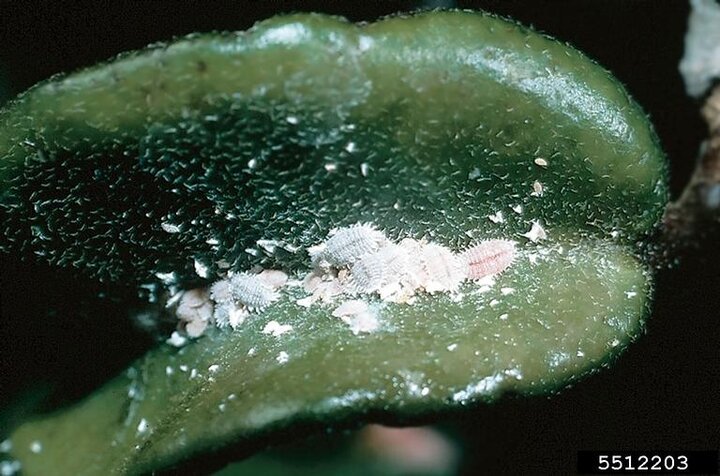Sarah Browning, Nebraska Extension Educator

Spider mites are very small and difficult to see until populations are very high. William Fountain, University of Kentucky, Bugwood.org.
Common pests of houseplants include aphids, mealybugs, whiteflies and spider mites, and it only takes a few insects hitchhiking into your home to multiply into an outbreak. Many gardeners prefer not to use standard insecticides, especially in the house. That may be one of the reasons why insecticidal soaps, both pre-mixed and homemade, have been gaining in popularity.

Using Soap for Insect Control
Insecticidal soap is one way to control soft-bodied insects like those mentioned above, however, it's not fully understood why they work. Their active ingredient is potassium salt of fatty acids, which may disrupt cell membranes or remove protective wax which causes the insect to die from water loss.
Whatever the killing mechanism, it's important to understand the limitations of insecticidal soaps.
- There is no residual activity. The product must wet the insect to kill it.
- Repeated applications will be necessary.
- Ready-to-use insecticidal soaps are made from products selected to control insects, minimize plant damage and have a consistent concentration.
- Homemade soap sprays may cause plant damage - browning or "burning" of leaves or stems - called phytotoxicity.
Ready-to-use products commonly available in garden centers include Safer Insect Killing Soap or Bonide Insecticidal Soap. Always follow the label directions for the best results effectively controlling insects and minimizing plant damage.

Homemade Insecticidal Soap
Some household hand soaps and liquid dishwashing detergents can be used to make effective insecticides. But always keep in mind, these products are not formulated for use on plants and the chances for phytotoxicity damage is higher than with ready-to-use products. Dry dish soaps and all clothes washing detergents are too harsh and should never be used on plants. However, some household soaps and liquid dishwashing detergents are poor insecticides, so experimentation is needed to find one that works.
Some plants are more susceptible to phytotxocity than others, so test both ready-to-use and homemade products on a small area of the plant before spraying the entire plant. Observe the treated leaves or section for a couple days to see if any damage develops. Potential for plant injury can be reduced by using the lowest percentage soap solution needed for insect control.
Potential for plant injury can be further reduced by washing or wiping plant leaves and stems to remove any spray residual a couple hours after the soap spray application.
If you want to mix up your own insecticidal soap mixture follow the guidelines below. Each dilution rate is the amount of soap used per quantity of water (gallon, quart, pint) to make the final spray solution. Using very hard water to make the spray will lessen its effectiveness at killing insects. Consider using distilled or rainwater, if necessary.
Approximate mixture "recipe" to produce a diluted water and soap spray.
- 1% soap solution – 1.5 tablespoon/gallon, 2 teaspoon/per quart or 1 teaspoon/pint
- 2% soap solution – 5 tablespoons/gallon, 4 teaspoons/quart or 2 teaspoons/pint
- 3% soap solution – 8 tablespoons/gallon, 2 tablespoons/quart or 1 tablespoon/pint
- 4% soap solution – 10 tablespoons/gallon, 2.5 tablespoons/quart or 4 teaspoons/pint
Making Applications
Because of the lack of residual action by soap sprays, repeated applications at short intervals are needed to control insects which reproduce rapidly. Killing 100% of insects with the first application is nearly impossible. In addition, eggs present at the first application will hatch within just a few days. Preventing these remaining insects from maturing into adults and laying more eggs is the key to long term control. Start with at least 2-3 applications at 4-7 days intervals.
For help identifying pests and more detail on each of the common houseplant pests, including pictures, visit Managing Insects on Indoor Plants from the University of Minnesota Extension.
Search Our Archive
Associated Video
Safer Solutions
Nebraska Extension Educator Sarah Browning talks about safer chemical solutions to use around your home landscape and garden.